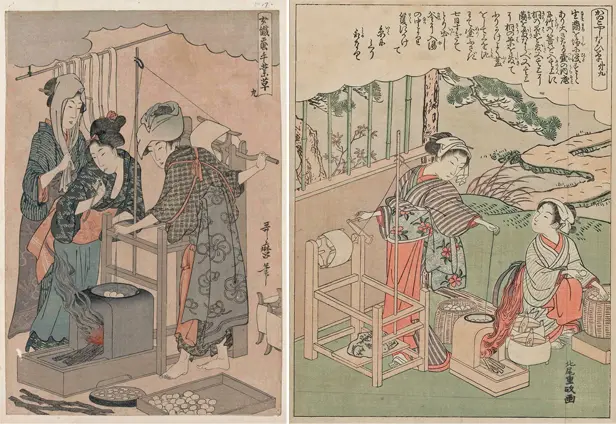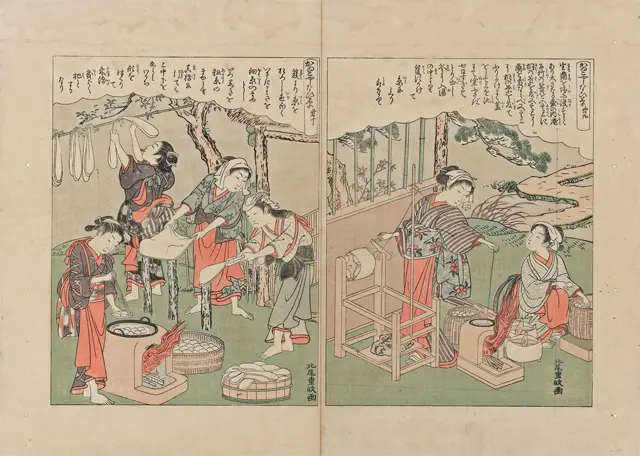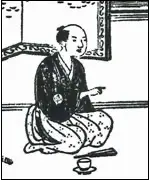
Some of the prints on display (left) “Joshoku kaiko tewaza-gusa 9 Teori” by Kitagawa Utamaro, (right)
"Kaikoyashinahi-gusa 9 Teori" by Kitao Shigemasa
About GUNZE
Business
Research & Development
Sustainability
Investor Relations
The exhibition theme is "Ukiyo-e prints of women engaged in the sericulture industry by Kitagawa Utamaro and achievements of Ukegaki Morikuni, the father of modern sericulture in Japan".
Osaka-Gunze Limited (Headquarters: Osaka, Japan, President: Toshiyasu Saguchi) [TOKYO: 3002] is pleased to announce that the Gunze Museum in Ayabe City, Kyoto, the birthplace of the company, will hold an Ukiyo-e special exhibition from October 14, 2023.
The exhibition will feature Ukiyo-e works by Kitagawa Utamaro, an Ukiyo-e print artist who was considered incomparable in depicting the delicate expressions and beauty of women and whose works were popular in Edo and internationally acclaimed. An illustration book "Kaikoyashinahi-kusa" is a joint work by Katsukawa Shunsho and Kitao Shigemasa will be also exhibited. These Ukiyo-e prints vividly depict women engaged in the sericulture industry in "Ehon takarano ito", a sericulture manual. In this exhibition, the differences in facial expressions, gestures, and characteristics of the women depicted by each artist are displayed for visitors to compare.
In addition, the achievements of Morikuni Uegaki, who worked to modernize sericulture in Japan from the Tajima region in the late 1700s, the same period as Utamaro, are presented through his book "Sericultural Secret Record.

Some of the prints on display (left) “Joshoku kaiko tewaza-gusa 9 Teori” by Kitagawa Utamaro, (right)
"Kaikoyashinahi-gusa 9 Teori" by Kitao Shigemasa
Ukiyo-e is a type of Japanese woodblock print that was popular from the Edo period to the Meiji period; many ukiyo-e prints were created to depict the lifestyle, customs and fashions of the time, with nishiki-e, or multi-color woodblock prints, being particularly popular with people. This exhibition shows a total of 12 prints from this series, "Joshoku kaiko tewaza-gusa", a series of prints from Utamaro's later years. Please enjoy the delicate expressions and expressions of beauty of the women depicted by Utamaro, who excelled in painting pictures of beautiful women.
This exhibition also allows the visitor to see the differences in the expression and touch of Kitagawa Utamaro, Katsukawa Shunsho and Kitao Shigemasa, three painters who worked at the same time and painted the same motif.

The series of Ukiyo-e prints of women engaged in the sericulture industry in "Kaikoyashinahi-gusa"
Born in Oya, Yabu City, Hyogo, Japan. At the age of 18, he went alone to Oshu District (northern part of Japan) to develop industry in the Tajima Region. He spread sericulture techniques in the Tajima area. In his later years, he compiled the principles and techniques of sericulture in his "Secret Record of Sericulture," which was published in 1803. The book, which was also translated into French, is considered the first export of Japanese technology, and is said to have been reimported in a different form by the Tomioka Silk Mill.

Uegaki Morikuni (1753-1808)
Gunze was founded in 1896 by Tsurukichi Hatano in Ikaruga Ward (now Ayabe City) to promote the local silkworm industry. The founder had an enthusiastic determination to contribute to the development of his hometown community by promoting the local silk industry. He believed that this should serve as Ikaruga's policy, so he named his company Gunze Silk Manufacturing Co., Ltd. (later renamed Gunze Limited), with "Gunze" meaning "district policy" in Japanese. Today, Gunze is a leading designer and manufacturer of plastic films, engineering plastics, medical devices, electronic components, apparel and other products. Gunze employs more than 5,200 people in 10 countries around the world.